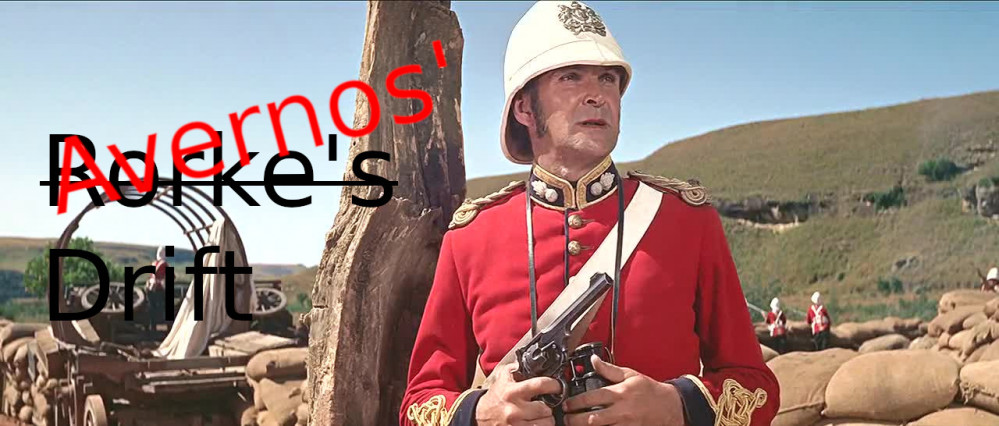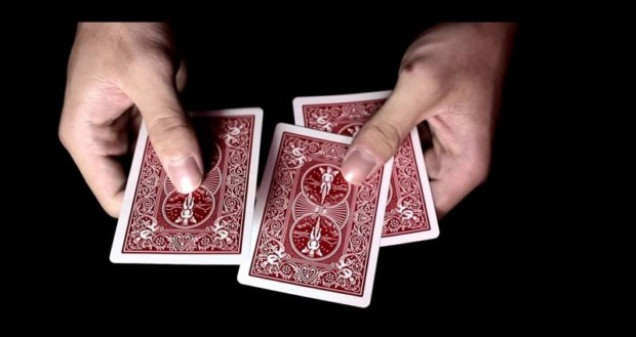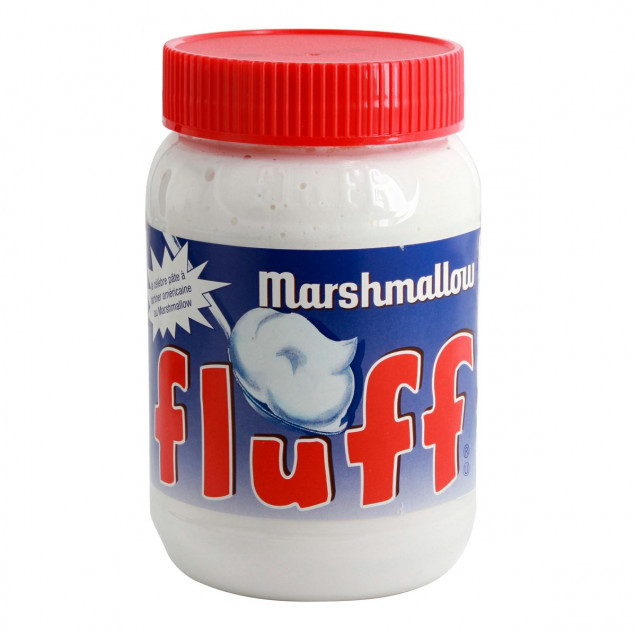
Avernos' Rorke's Drift
Designing the Drift
While the film Zulu does take some liberties with characters and details, it’s remarkably accurate for hitting the beats of the actual action, and this is what I wanted to recreate in a large participation game. Rather than aiming for complete historical accuracy the game should capture the feel of the movie. So to me that means at it’s core a siege with wave attacks and I set about finding a ruleset that could do that, which I can build on top of.
As luck would have it after a tireless search of literally some rulesets I came across The Men Who Would Be Kings (TMWWBK for short) by Daniel Mersey. This seemed to be exactly what I was after, a rules set for 30 – 120 figures per side in the colonial era. Let’s take a quick look at the set itself before I get into the set up for the scenario and how I recreated Rorke’s Drift.
TMWWBK uses a simple IGO – UGO system were players activate unit about giving them simple orders, running at the double, charging, firing and the like. However there are some variations, tribesmen can go to ground, while the regular troops can form close order ranks and volley fire. The units are activated by making an order check on 2d6 and adding any discipline and getting over their units leadership value. Leaders can however be taken out of action, in any round when the unit has taken a casualty roll 2d6 and on a double one the leader dies. Which gives good scope for having each unit of the defenders lead by one of the more prominent characters from the film and adds a bit danger to every clash.
The statline is very simple, speed, fight, fire, discipline are the only things with a number, and then equipment and special rules. For participation games where people may not only be unfamiliar with the rules but with wargaming in general less is most definitely more. Leadership for units is normally rolled randomly at the start of the game for each unit and recorded. So sometimes your lions really are lead by lambs, or in some cases drunkards. There are even optional traits for your overall general, such as being a complete cad and always retreating at full speed to save his own skin!
Combat and shooting is very simple, roll equal to or higher than the stat. A success is a casualty with no save. No modifiers are made to the result, instead the number of successes required to cause a casualty is increased. So if someone needs 5+ to hit, they will only ever need that, but aiming at a unit behind a wall at long range may mean you need four successes to kill one man. Another great little mechanic and handy for me as I can go ahead and tell people to count the successes and I can do the simple calculations to tell them how many to remove. No complicated tables thank you very much Mr Mersey.
So how did I adapt this to the table top. I’m going to break this down into three sections, scenario rules, British Forces and Zulu forces. The forces will be in the next posts, but for now I shall focus on the scenario itself.
Knowing that it is essentially a siege the first thing to sort out are the victory conditions for the game. Thankfully history helps us out here. The attack on the Drift lasted for twelve hours until the sign of the relief column of cavalry drove the Zulu off (or they gave up and saluted fellow braves if you want to stick with the film). So this gave me a turn limit, one turn per hour, twelve turns. At the end of the twelfth turn if the British had any unpinned units within the perimeter then they had held and the Zulus would melt off into the African veldt. On the other hand if the Zulus can overwhelm the defenders regardless of the hour, day or night, they win immediately.
So with win conditions and turn limit established it was time to look at the meat of the game. Alternate unit activation is great for a small number of friends playing together, but in a large participation game it can get dull, people aren’t engaged and sometimes arguments break out over who really deserves to go next. This was solved by my favourite gaming aid, as any bootcamp attendees may know, the humble deck of cards. By assigning a card to a unit and shuffling people have to pay attention as they don’t know what is coming next. In my original game I had six British platoons and five Zulus to represent the snipers on the ridge and the four ibutho present. This left me with a problem, two actually, the British now outnumbered the Zulus in activations and even though the Zulus had more men per unit they didn’t look like they were going to exactly swarm over the massively outnumbered defenders. While I didn’t want the defenders to be blown away by 30 times their numbers, I didn’t want to make it too easy to defend and still give the attackers some decisions to make. To this end I introduced two Zulu units per card. Now each of the four ibutho consisted of thirty two men instead of the paltry sixteen. However, the card could only be used to activate one of the units per turn, the exception being for movement if both units are close enough they can maneuver as one. This allows the Zulus to move a large wave up and force the defenders to chose who to shoot, knowing a unit may still be there at full strength. The final thing I added was a Joker to the Zulu deck. This did two things. Firstly it balances the number of activation cards for both sides and it is a bonus action. So a unit that has already acted could act again, or even use it to make both units in an ibutho act in the same turn.
The Zulu units can also be recycled by using their card to retire a unit or if it had been completely wiped out. The unit can be brought back on with an activation card. Potentially a unit wiped up could be immediately brought on with the Joker in the same turn to keep the pressure up, which is a nice touch I feel.
Deployment came next, the British is simple they deploy anywhere within the defensive perimeter with only two stipulations. No platoon can begin inside the final redoubt and Hook has to start with his platoon inside the hospital.
The Zulus are a little bit different. Once the british have been deployed the Oskarberg snipers can deploy anywhere on the ridgeline, they can’t move off that area either. But to account for the initial piecemeal attacks the ibutho units on the ground deploy randomly on a 1-3 up to 6” in anywhere along the short left hand table edge, and one a 4-6 up to 6” from the long northern table edge as far as where the road enters the table. This gives them roughly a five foot by 4 foot deployment area. Any recycled units also roll to see where they come on, so potentially two units on the same card could be separated if the player chooses to bring them back in straight away instead of waiting for both units to be off table. This lasts for the first three turns, from turn four onwards they can choose to deploy from any edge once the Prince has arrived and started giving the orders.
So there were a few things that I wanted to do to make it more like the film, and weirdly like the historical action.
There are no rules for buildings, and since the 4Ground terrain have rooms inside them I simply decided that a normal move was into an adjacent room, and an “at the double” action was two rooms. In the vein of keeping it simple.
The only other rule changed was to increase the successes needed to cause a casualty in hand to hand. The defenders bonus is normally one additional success to cause a wound. But in play testing it didn’t take long for the Zulus to deal heavy damage to the British, so two additional successes are needed when fighting across a defended obstacle. Which gives the defenders a bit of staying power.
To reflect that the action took place over twelves hours I’ve included four turns of “complete darkness” turns 6-9 inclusive have a reduced visibility for shooting unless within 18″ of the burning hospital, in which case they can be picked out as normal.
Speaking of burning hospitals this is the thing that has changed most often. Originally I had it go off at a set time. Then I had it randomly rolled for. Then I set it off but rolled randomly to see the spread of the fire. Finally I settle on this. On the third turn the three outer rooms closest to the left board edge fill with smoke, each turn thereafter the smoke progresses to the adjacent rooms. People have that turn to get get out, the turn after it fills the smoke becomes flames and anyone inside dies. No leader casualty rolls are needed as the models in the room are the ones who should suffer. By turn seven the last room is full of smoke and turn eight the building is merrily ablaze.
Lastly I added two pairs of individuals that I control to the defense. The cook and Commissary Dalton making the rounds with the ammo. They defenders get to choose where they start, after that they move clockwise 8″ a turn handing out ammunition and allowing one unit within 4″ to reroll shots that turn. In the base of several units being applicable the defenders have to choose which will receive the bonus before the cards are drawn.
In a more historic slant Pip the dog and Daniels the ferryman also join the defense. They start in the centre of the defenses and randomly move 2d6 at the beginning of each turn, I use a scatter die but various techniques to decide on the direction can be used. Daniels has a shotgun that he will use if necessary to defend himself and Pip. Meanwhile Pip was lauded as stopping several Zulu sneak attacks. Any Zulu units with the majority of the miniatures within 18″ of Pip count as having one less level of cover as he barks out warnings.
So that’s all for the scenario and rules, next up are the forces starting with the Zulus.















































































Very interesting I like the way you’ve not only chosen a thematic game system but then added your own twist to it. To me that’s what playing these sort of thematic games is all about.
Playing Rorke’s Drift would be fun but playing Rorke’s Drift while ammunition is hastily being passed around and you actually have a connection to your “Character” is brilliant.
Thanks. It also allowed me to use Empress Miniatures lovely sculpts. He didn’t exist in early versions simply because the cook model didn’t, but once they released him I had to find a way to use him. Pip and Daniels were there from the start mind you.